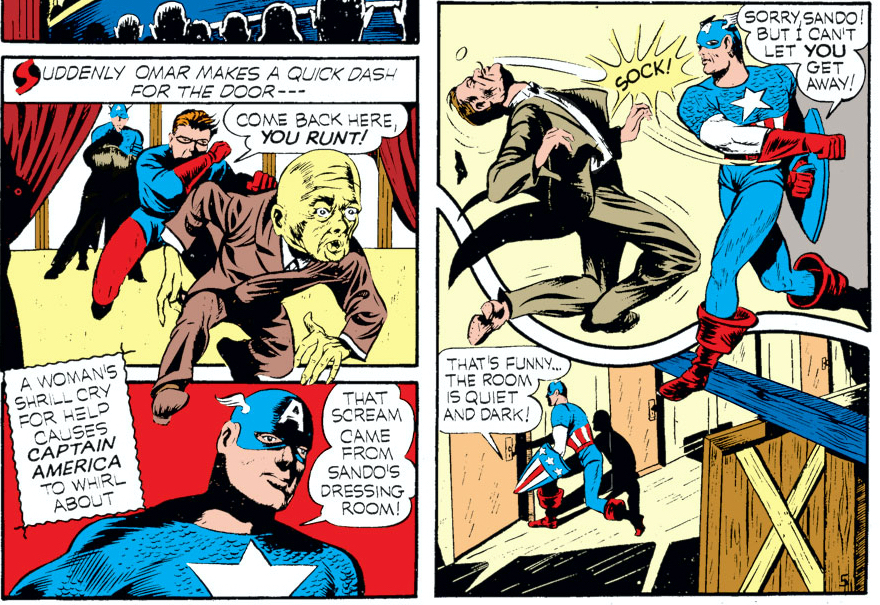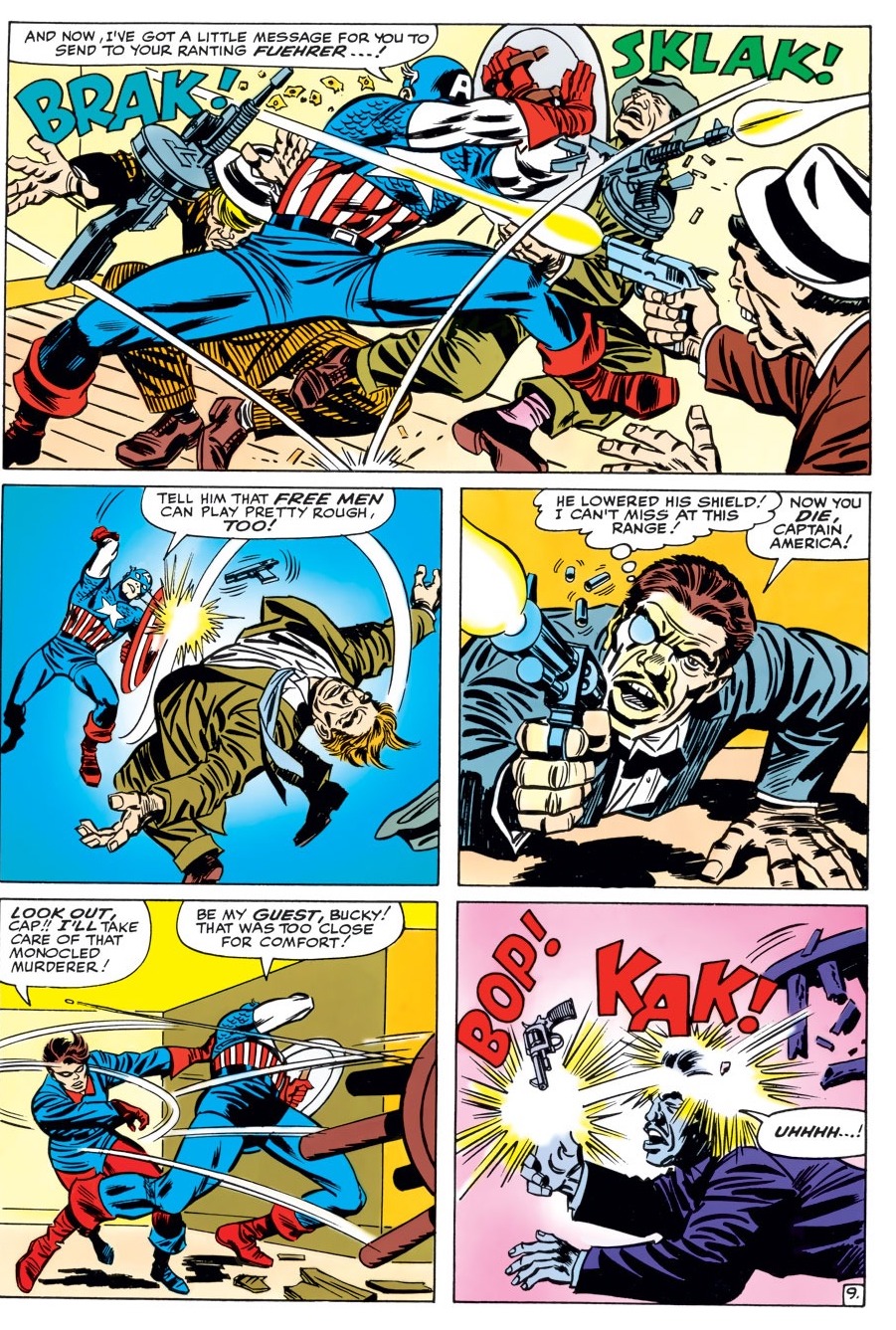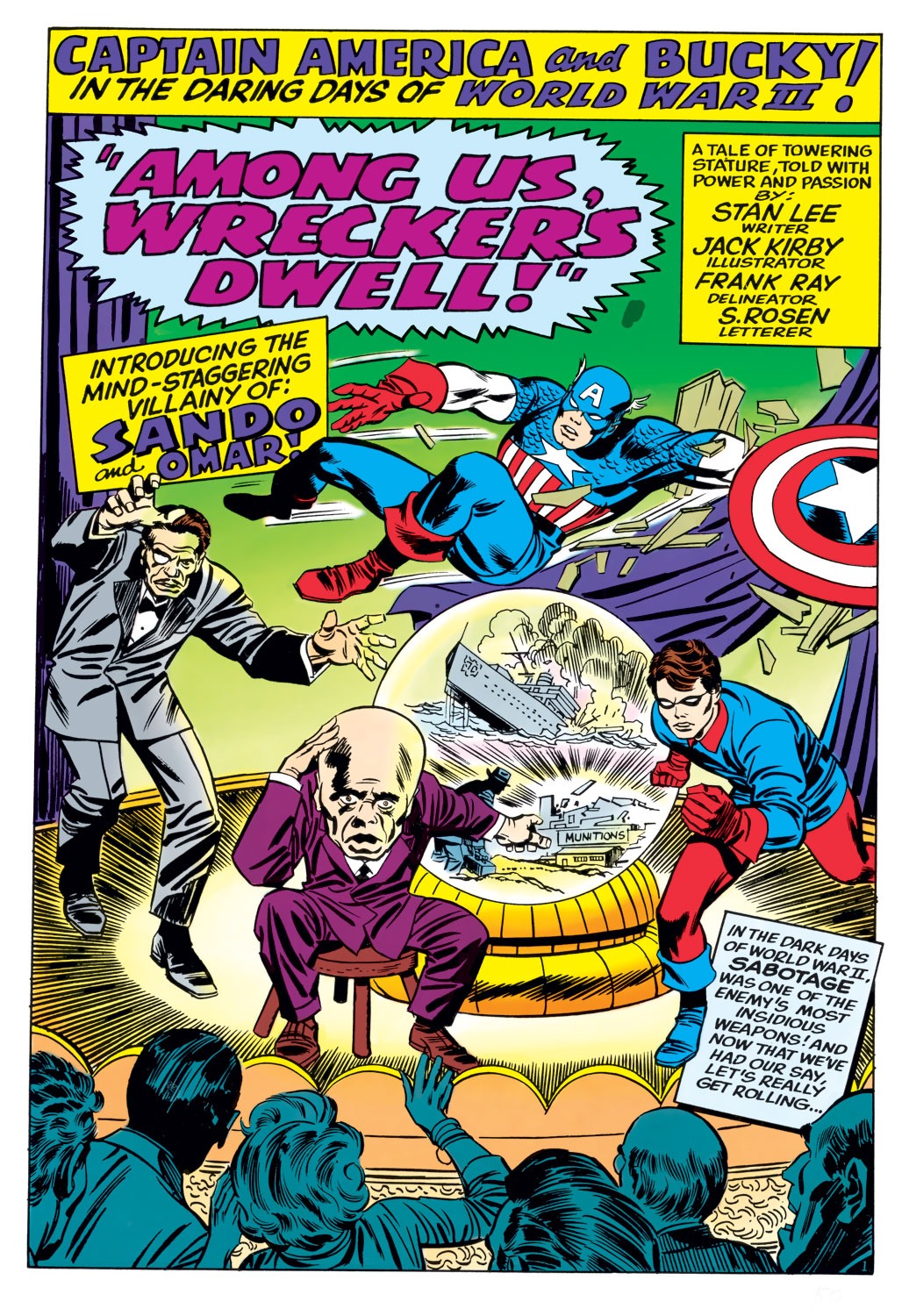Featuring: Captain America
Release: January 12, 1965
Cover: April 1965
12 cents
Writer: Stan Lee
Illustrator: Jack Kirby
Delineator: Frank Ray
Letterer: S. Rosen
10 pages
| Previous | #317 | Next |
|---|---|---|
| Prelude | Captain America Comics #1, Story C | |
| Tales of Suspense #64 | Reading order | Strange Tales #131 |
| Tales of Suspense #64 | Tales of Suspense | Tales of Suspense #65 |

This is an extremely close retelling of the second story from Captain America Comics #1, which we covered back when Captain America first returned in Avengers #4.
The original story is most notable for being Captain America’s first case and for introducing Betty Ross.
I see I didn’t go into great detail on the plot in that post, writing this:
The story of the comic doesn’t make any sense whatsoever. I can’t begin to try to explain it and I’m not sure it’s worth considering all the many ways in which it makes no sense. Suffice it to say they stop the bad guys.
We’ll delve deeper here.
Last issue was a close retelling of the first story from Captain America Comics #1, which was the story of Captain America’s origin. Next issue will be a retelling of Captain America’s first battle against Red Skull from the same issue. It makes sense why one might want to revisit those two stories. And then there’s this one.
The original stories are by Joe Simon and Jack Kirby. Joe Simon’s name should probably have been in the credits of this comic, as it’s based so closely on his original story. The plot owes more to Simon than many of the comics Stan Lee claims “plot” credit on owe to Stan.
My issue with the original is that I didn’t really understand what Sando and Omar brought to the scheme. There were Nazi saboteurs in America successfully blowing things up. Why have a member of your crew go onstage and warn people about the attacks in advance by pretending to be psychic? The comic didn’t really try to explain.
Let’s compare the new one to the original. The first thing we will notice is the new one fits into very regular grid patterns that make it easy to crop out groups of panels. The original felt bound by no such structure, so the croppings will all be imperfect.
Looking to the opening splash pages, the crystal ball image is very close. The changes fit Kirby’s more dramatized style and generally make a more modern splash page. Omar is a little less freakish in the new one. The biggest loss is Sando, whose fingers had an unusual positioning in the original, almost suggesting his role as puppeteer. Kirby opted for a more standard-for-Kirby dramatized positioning.
The modern comic claims to be “introducing” Sando and Omar. This seems blatantly false, as they were obviously introduced 25 years earlier.


Stan of course adds more narration to his version, with his usual poetic flair.


Stan earns his paycheck. He doesn’t believe in using one word when two will do. In both opening panels, Stan just uses a lot more words to tell the story.


We see here that the original was much harder to crop because of the irregular page layouts. Stan and Jack make an interesting pair when it comes to storytelling economy. 1960s Jack often realizes he can convey the same information in less panels than he had used the first time. Stan always seemed to feel far more dialogue was needed.
Kirby decided the audience shots were superfluous. He also removed the psychedelic panels with all the crazy eyes, favoring a close-up of Omar’s eyes. The close-up of eyes shot is one we’ve seen a few times now, basically a Kirby trademark at this point.


Same accident. Tanks blowing up. The newer version keeps the tank larger, putting the focus on what is being blown up.
The big story difference is the accident was at Fort Bix, not Captain America’s own Fort Lehigh. Lee seems to not feel at all constrained by the original, and setting it at Cap’s own base does serve the narrative better.


The scene matches, but the characters look pretty different. Kirby’s art just got more consistent over time, and his modern take on Captain America is just bigger overall, particularly with a bigger head. That original Bucky just looks poorly drawn. 1960s Captain America doesn’t smoke a pipe. In the 1960s, that’s something only professors and scientist types do.

The new version adds four panels with Sgt. Duffy, who wouldn’t be introduced until the next story in the original issue. Its flavor is consistent with many Sgt. Duffy scenes from the 1940s.



We get an added scene in the new version, which suggests Kirby was aware of some of the narrative issues in the original, and trying to correct them. That woman will turn out to be Betty Ross. In the original, we will meet her when she’s already a hostage. These two panels give a better introduction to who she is and what she’s doing there, so there’s not just a girl hostage out of nowhere.
In the original, Cap and Bucky attack Sando and Omar on stage with no evidence of anything whatsoever. In the new version, they’ll attack based on very slight evidence, but it’s better than nothing. Hence why Kirby added this scene to show them doing some investigating back stage before resorting to violence.


Both versions show Cap and Bucky getting ready for action as Omar predicts a bridge collapse. The differences again just come down to Kirby’s newfound desire for economy in panel use.

This added scene in the new version shows the results of the investigation. Cap and Bucky learn Omar is not psychic, but that the act involves some trick camera work. On that basis, Kirby will now have them storm the stage to attack as they did in the original.
It’s an improvement, but all they’ve really shown is that the magician’s tricks are just an illusion. That’s not a good reason to go attack the magician.


The new version has the addition of Cap kicking the crystal ball. A nice effect.


The scenes are similar. Even some hints of dialogue similarity, enough to indicate that Stan read the original (or got some notes on it). The modern scene works better precisely because of the added scene earlier. We met a woman in a previous scene. Now we hear a woman’s scream. That’s pretty basic storytelling.
In the original, we hear a woman’s scream. Yet there had been no women in the story up to this point.




In the original, the woman introduces herself as Betty Ross and explains she’s been investigating Sando.
In the new one, we learn she’d been undercover as a reporter, but was really a special agent for the Women’s Army Corps working with the FBI to investigate the sabotage. She neglects to give her name.


Sando’s real name is Von Krantz in both versions. In the new one, we get his full name, Colonel Wolfgang Von Krantz.
In the original, he explains his acts of sabotage are meant to be a blow to America’s morale. Perhaps that hints at the reason for the act, to also help lower morale.
Honestly, it seems like a bad plan to me. America is neutral in the war. Acts of sabotage blatantly committed by Germany seem like a good way to swing public support in favor of war.
The best part of the original was when Captain America called Hitler the Phewrer. They should have kept the zinger in.





While Kirby had chosen to convey the narrative more efficiently up to this point, we’ve now reached the action scene. Captain America in action has been Kirby’s specialty for the entirety of this series, so he adds a whole extra page of fighting.
The original fight involved a bomb, which is replaced with a gun in the new one. It’s the classical notion of a bomb, a black ball with a string fuse. Apparently, there were bombs that did really look like that, though they’re anachronistic in the 20th century. We mostly know them from pop culture, from Looney Tunes to Batman.
Here’s an interesting history on why we draw bombs that way from Atlas Obscura.


After the fight, the new version gives us the explanations the original gave us sooner. Sando planned the crimes and then “predicted” them in his show. Betty tries to explain it was indeed part of the plan to lower morale. I feel like the show just drew attention to them and gave early warning of their crimes. I would have skipped the show and gone straight to the sabotage if I were a Nazi spy.
The woman still refuses to give her name in the new one, referring to herself as Agent Thirteen.
I think this is a good time to give some clarification on the various women in Captain America’s story up to this point, as they all get confused. I mix them up. Many online sources mix them up. And many later Captain America writers mix them up, retroactively revealing who is and isn’t who.
We’ll take a 1965 perspective with a little bit of peek ahead.
From the 1940s, there are two women to know.
One is Agent X-13, the spy who was present at Steve Rogers’ transformation into Captain America, introduced in the first story of Captain America Comics #1. She will not be seen again in the 1940s.
The second is Betty Ross, a special agent who is the main woman in Captain America’s life in the 1940s, occasionally helping him on cases or needing rescuing. She eventually trains to become Captain America’s sidekick, the Golden Girl. She also sometimes calls herself Betsy Ross. In the 1950s, she is no longer a special agent, but a reporter.
In the 1960s, we will meet 4 women of note.
We met the woman present at Captain America’s origin in Tales of Suspense #63. She was referred to as Agent R. This is the same person as Agent X-13 from the 1940s, just with a new designator in the modern continuity.
In this issue, we meet Agent 13. She has clearly never met Steve Rogers before now. She has the same role in the story that Betty Ross did in the original. Despite the similarity in designator, she is not Agent X-13 nor Agent R. She was not present at Captain America’s transformation. She met him now, on his first adventure. She really is Betty Ross, though not named as such.
We’ll eventually meet a French resistance fighter Captain America fell in love with in the 1940s.
We will also meet her younger sister, who Captain America falls in love with in the 1960s.
Those women turn out to be Peggy and Sharon Carter. Sharon Carter will eventually be known as Agent Thirteen, which matches the designator we just learned Betty Ross had.
There are four different women here, one sometimes called Agent X-13, and two sometimes called Agent 13, hence much confusion.
We’ll keep paying attention to this as it goes on.
For this blog’s evolving canon, we are focusing on what is on the page from the 1960s comics. We’re not worried about what any comics say prior to 1961 or later than January 1965. In this canon, there are two women from the 1940s we have met: Agent R and Agent Thirteen. In the character listing below, we refer to her as Agent Thirteen until modern evidence clarifies her real name.
Final note on character listings. This issue does clarify Rogers’ sergeant is Sgt. Duffy, which matches his name from the 1940s comics, as first revealed in Captain America Comics #4. He appeared last issue, but was only identified as Sarge.
Rating: ★★½, 47/100
Significance: ★★★☆☆
This wasn’t a good story to begin with. They retold it with changes that make it a little better. Better than next issue, where they’ll take a good story and retell it with changes that make it a lot worse.
I read this story in Marvel Masterworks: Captain America Vol. 1. You can also find it in Captain America Epic Collection vol. 1: Captain America Lives Again. Or on Kindle.
Characters:
- Sando/Colonel Wolfgang Von Krantz
- Omar
- Captain America/Private Steve Rogers
- Bucky/Regiment Mascot Bucky Barnes
- Sergeant Duffy
- Agent Thirteen
Story notes:
- Sando hypnotized Omar and Omar projects his thoughts of the future into the crystal ball.
- Ball accurately predicts explosion of US tanks on Fort Lehigh.
- Omar predicts collapse of bridge which connects Camp Kosgrove to the mainland.
- Agent 13– Special Agent for Women’s Army Corps disguised as reporter, cooperating with FBI.
- Omar an innocent pawn hired from freak show.
| Previous | #317 | Next |
|---|---|---|
| Prelude | Captain America Comics #1, Story C | |
| Tales of Suspense #64 | Reading order | Strange Tales #131 |
| Tales of Suspense #64 | Tales of Suspense | Tales of Suspense #65 |




